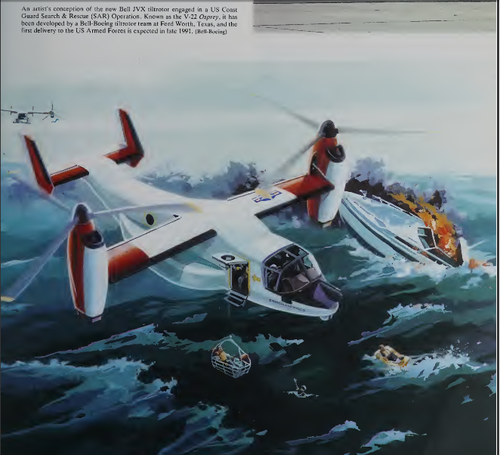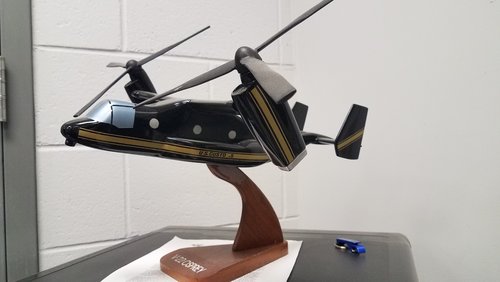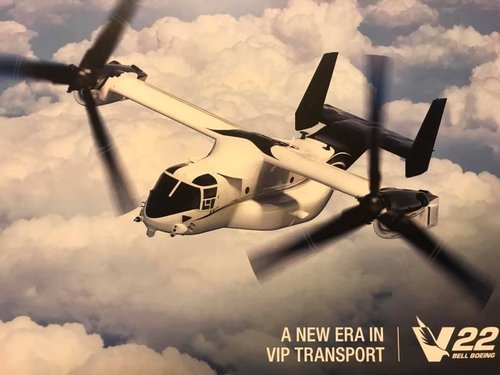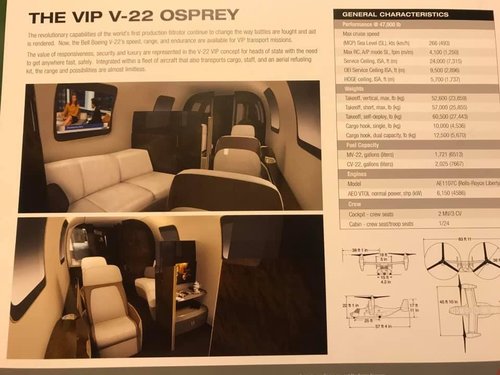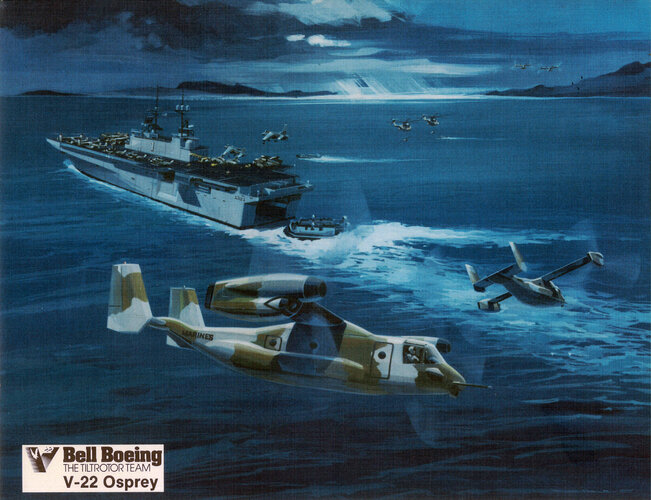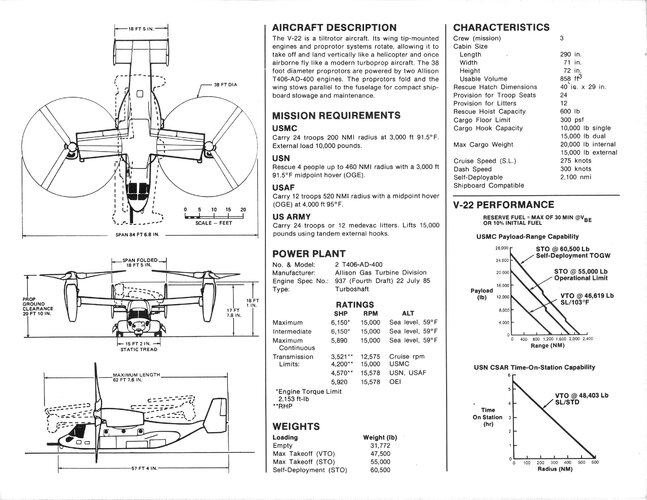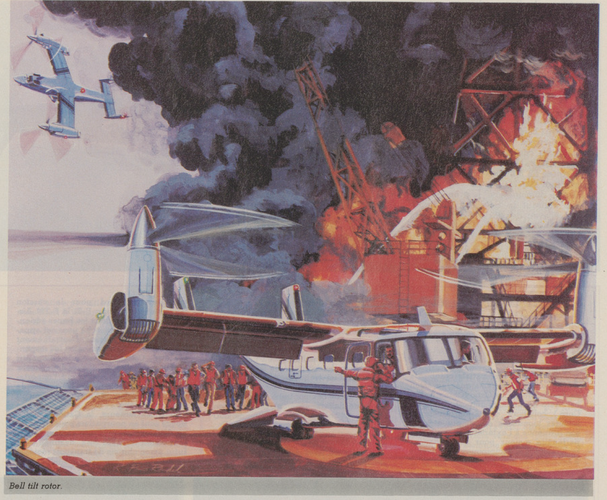You are using an out of date browser. It may not display this or other websites correctly.
You should upgrade or use an alternative browser.
You should upgrade or use an alternative browser.
Bell Boeing V-22 Osprey - Development and Proposed Variants
- Joined
- 5 May 2007
- Messages
- 1,483
- Reaction score
- 2,859
As it's described as an 'artist's concept', the picture may be everything on that particular stopped-rotor concept. Since it features the other wonder-tech of 1980s aeronautics, the forward-swept wing, an artist's (or marketeer's) fancy seems quite likely to me.Don't think I've ever seen anything on the drawing in the lower left hand corner.
Interesting nuggets of information about the SV-22 on there. It could have been a very capable aircraft, and could conceivably have got some export orders.
The D-340 gets my vote on sheer adorableness, even without a specific application for it!
- Joined
- 8 January 2006
- Messages
- 1,612
- Reaction score
- 762
That would be a tempting variant to model, along with the SV-22B. I've been sorely tempted to also do one in US Forest Service markings as a fire bomber using a mini-MAFSS and taking on water from a lake in hover mode.From; A history of U.S. Coast Guard aviation.
- Joined
- 8 January 2006
- Messages
- 1,612
- Reaction score
- 762
Yet another interesting possibility. Lots of potential uses for the older and inaccurate V-22 kits (in 1/72, essentially any kit but Hasegawa's - note that the picture of the Blackdog engine nacelle details for this one have the bottom access doors hinged on the wrong side, they are hinged on the bottom and have struts holding them open; in 1/48 I do believe Italieri updated theirs to be reasonably accurate but check carefully).
RavenOne
ACCESS: Top Secret
- Joined
- 18 June 2008
- Messages
- 1,003
- Reaction score
- 2,676
Then there is this Bell pipe dream.
Unless you have read Dale Brown’s Hammerheads and the subsequent novels involve The Border Security Force , disbanded US cUstoms Service (sounds familiar decade and half after publication when USBP and Customs formed CBP) and UsCG , in Storming Heaven. The fictional BSF flies the V-22 Osprey In his books.
Cheers
- Joined
- 8 January 2006
- Messages
- 1,612
- Reaction score
- 762
Current HMX-1 birds are primarily cargo haulers with passenger capacity rather than executive transporters. There were proposals for a "White Top" VM-22B but there were some drawbacks that didn't see it compete (engine exhaust impingement on the ground is more problematic for VIP aircraft, as one concern). ISTR that the back ramp was replaced by a stairway.Btw attended International Military Helicopter conference last week and came across the Bell booth. They Are advertising VIP configuration for V-22 But nothing like HMX-1 birds
Cheers.
View attachment 628450View attachment 628451
- Joined
- 25 January 2020
- Messages
- 1,279
- Reaction score
- 1,953
Another article about the armed V-22
 foxtrotalpha.jalopnik.com
foxtrotalpha.jalopnik.com
The V-22 Osprey Finally Gets The Missiles And Rockets It Needs
The Osprey has always lacked firepower in its forward hemisphere. Beyond its ramp-mounted gun, various concepts have been tested and fielded in an attempt to provide fire towards where the aircraft is headed, not just where it has been. This issue is compounded by the fact that the Osprey...
- Joined
- 8 January 2006
- Messages
- 1,612
- Reaction score
- 762
Well, most of that is old news, like four years old as the airframe loaned for the ATTR has been returned to the USMC some time ago after being returned to close to the stock condition it was received in (it was an old airframe from early LRIP production and showed it). The cheek weapons stations work with existing structure and, really, unless you are dropping something that doesn't need to hasten forward, they are the only location for weaponry. Now, if you are just dropping something, you could likely carry *that* behind the prop-rotors.
aonestudio
I really should change my personal text
- Joined
- 11 March 2018
- Messages
- 2,964
- Reaction score
- 7,493
- Joined
- 18 October 2006
- Messages
- 4,211
- Reaction score
- 4,919
I am happy to see that the system is still being worked. I had thought it not is use after the initial test.
Firefinder
ACCESS: Top Secret
- Joined
- 5 October 2019
- Messages
- 1,048
- Reaction score
- 1,900
Its been in the fleet since at least 2016, saw it in Iraq at the time.I am happy to see that the system is still being worked. I had thought it not is use after the initial test.
But its mostly left out cause its heavy and cumbersome. So they often drop the gun but keep the sight since that thing is too useful.
Heard many pilots say that all military copters need a similar optic set up if they dont have one.
- Joined
- 29 September 2006
- Messages
- 1,793
- Reaction score
- 1,360
Interesting! Goes against the common perception that military folks want guns, guns, and more guns.Its been in the fleet since at least 2016, saw it in Iraq at the time.I am happy to see that the system is still being worked. I had thought it not is use after the initial test.
But its mostly left out cause its heavy and cumbersome. So they often drop the gun but keep the sight since that thing is too useful.
Heard many pilots say that all military copters need a similar optic set up if they dont have one.
- Joined
- 18 October 2006
- Messages
- 4,211
- Reaction score
- 4,919
Aero Scouts tend to prefer to let others do the shooting after they have found something worthy of being shot. Targets tend to shoot at those shooting at them.
As mentioned above, most lift pilots are ecstatic at getting any sensor beyond the Mark 1 eyeball, to help them see the environment around them.
As mentioned above, most lift pilots are ecstatic at getting any sensor beyond the Mark 1 eyeball, to help them see the environment around them.
Colonial-Marine
UAVs are now friend, drones are the real enemy.
- Joined
- 5 October 2009
- Messages
- 1,470
- Reaction score
- 1,323
I thought the MV-22 had a FLIR turret as standard? At some point a setup with a GAU-19 under the nose was envisioned, does anyone here know why was that idea abandoned?
- Joined
- 8 January 2006
- Messages
- 1,612
- Reaction score
- 762
It does, though, IIRC, the armed ATTR testbed had a different one fitted that included designation capacity. I suspect that, as yasotay says, weight and center of gravity concerns, as well as structural loads from the gun lead to that being delayed and then the necessary real estate for it in the fuselage got taken by other systems.I thought the MV-22 had a FLIR turret as standard? At some point a setup with a GAU-19 under the nose was envisioned, does anyone here know why was that idea abandoned?
aonestudio
I really should change my personal text
- Joined
- 11 March 2018
- Messages
- 2,964
- Reaction score
- 7,493
Intrepid Tiger II takes first flight on MV-22B Osprey | NAVAIR
The U.S. Marine Corps’ newest Intrepid Tiger II (IT II) Electronic Warfare (EW) capability flew for the first time on an MV-22B Osprey June 15. “The significance of this developmental test flight was two-fold,” said U.S. Navy Capt. Michael Orr, Airborne Electronic Attack (AEA) Systems...
- Joined
- 13 June 2007
- Messages
- 2,173
- Reaction score
- 3,093
A recent donation to the Museum from the widow of a Boeing Vertol/Boeing St. Louis Engineer netted the attached brochure and cut sheet. Also a number of tie tacks, pins and other internal Rah-Rah epherma...
Enjoy the Day! Mark
Enjoy the Day! Mark
Attachments
that_person
ACCESS: Secret
- Joined
- 25 May 2021
- Messages
- 339
- Reaction score
- 650
Recently purchased Combat Fleets of the World, the 1988-1989 edition. It has this little section about the V-22. Talk about unrealistic deadlines...
Edit: Wrong image
Edit: Wrong image
Nik
ACCESS: Top Secret
- Joined
- 15 July 2009
- Messages
- 1,269
- Reaction score
- 1,062
For some reason, I was reminded of another thread...
Why? Because that thread is heavily populated by the Secret Project Forums favorite, most beloved and least controversial poster?For some reason, I was reminded of another thread...
- Joined
- 16 April 2008
- Messages
- 9,605
- Reaction score
- 14,494
Seems more elegant than the finished product. But then, isn't that always the case?
Often, though not always. The early JVX had a more conventional aircraft shape to the cockpit; it got squarer as it developed as that allowed the pilot better vision, kinda important for a VTOL. Almost surprised it didn't end up with a bug-eyed OV-1 style cockpit. Then fuel tanks get bigger, it starts sprouting antenna and ECM lumps and flare dispensers and beer volcanoes and stripper factories...Seems more elegant than the finished product. But then, isn't that always the case?
- Joined
- 18 October 2006
- Messages
- 4,211
- Reaction score
- 4,919
Well, here is to hoping that Leonardo has more success with commercial tilt rotor aircraft.From Aviation magazine 1988.
Given the lethargy of the US and European aeronautical approval agencies I am not as optimistic as I would like to be.
- Joined
- 8 January 2006
- Messages
- 1,612
- Reaction score
- 762
Now that the V-280 has won the US Army contract, I could see a development of that installation concept applied to new wings as a Mid-Life Update of the V-22B into the V-22C. It would eliminate some problems the V-22B encounters.
Last edited:
- Joined
- 18 October 2006
- Messages
- 4,211
- Reaction score
- 4,919
While it is feasible that a new wing could be developed that moves the engines to a permenant horizontal position, the wing could not be made straight like the V-280 due to the relative position of the prop rotors to the ceter of gravity in helicopter mode. Someone with more aerospace engineering background will have to remark if there are any other aerodynamic issues associated with the modification of the wing to accept a non-rotating engine component.
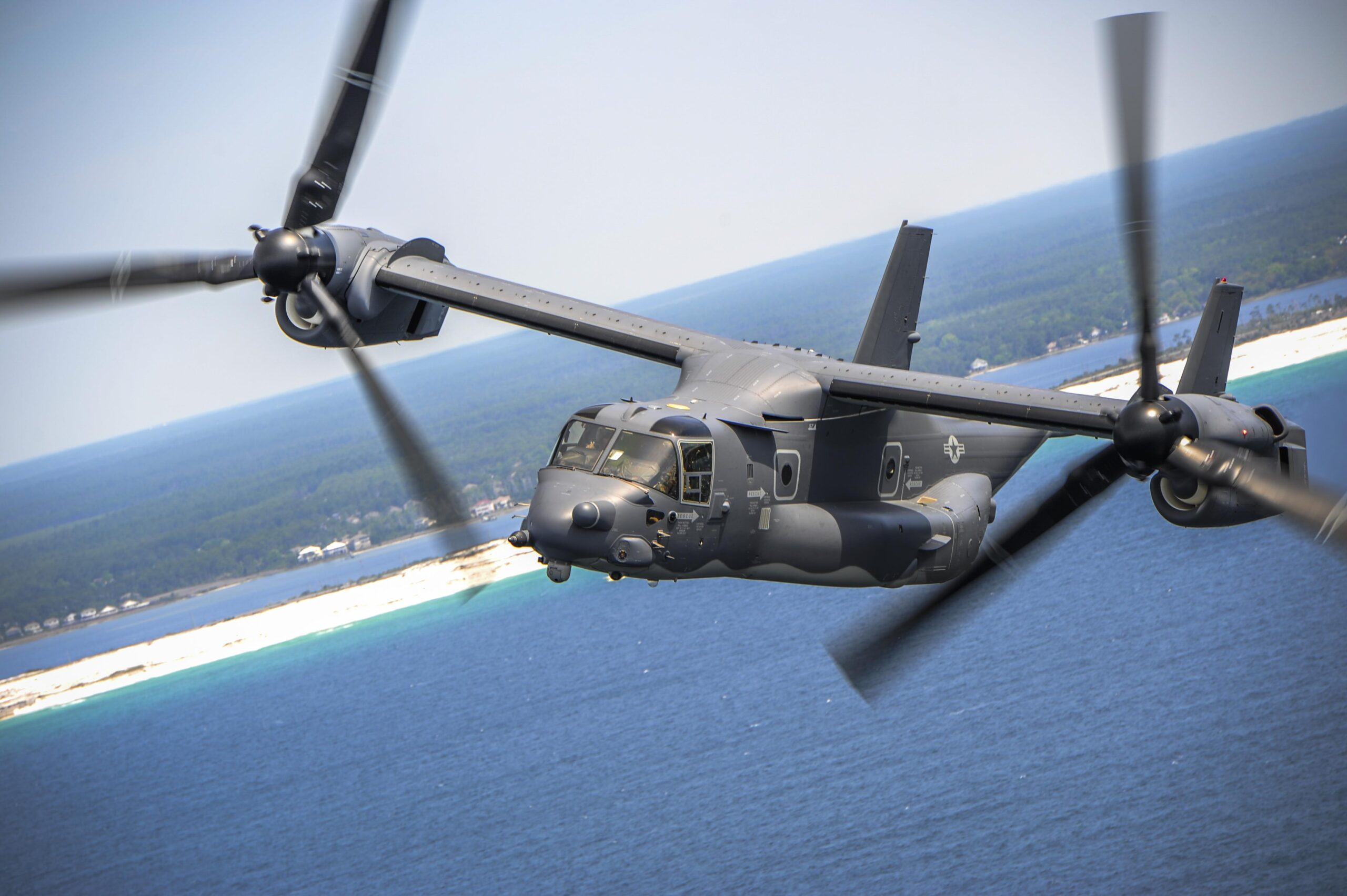
End of V-22 Production Signals Failure of Pentagon's Wishful Thinking
The V-22 tiltrotor production line is slated to shut down in 2026, given the lack of Pentagon orders for more of them in next year’s budget. Its fate ...
 www.defense-aerospace.com
www.defense-aerospace.com
- Joined
- 18 October 2006
- Messages
- 4,211
- Reaction score
- 4,919
It would appear that 700,000 hours and over a decade of combat operations later, a tilt-rotor ...disliker, feels vindicated.
End of V-22 Production Signals Failure of Pentagon's Wishful Thinking
The V-22 tiltrotor production line is slated to shut down in 2026, given the lack of Pentagon orders for more of them in next year’s budget. Its fate ...www.defense-aerospace.com
Arbitary metric, 700,000 hrs/464 V-22 equals an average of only ~1,500 flight hrs per aircraft to date, for a $56 billion program cost plus its O&M costs and at first glance it doesn't appear a great return for the treasure heaped on it.It would appear that 700,000 hours and over a decade of combat operations later, a tilt-rotor ...disliker, feels vindicated.
End of V-22 Production Signals Failure of Pentagon's Wishful Thinking
The V-22 tiltrotor production line is slated to shut down in 2026, given the lack of Pentagon orders for more of them in next year’s budget. Its fate ...www.defense-aerospace.com
Similar threads
-
AAH Competition (AH-64 rivals)
- Started by overscan (PaulMM)
- Replies: 8
-
-
-
McDonnell Douglas & Boeing canard rotor wing (CRW) concepts
- Started by flateric
- Replies: 63
-
Development of Airborne Armament 1910-1961
- Started by RyanC
- Replies: 3

